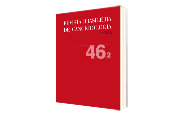Quimioterapia Neoadjuvante em Câncer de Mama Localmente Avançado: Análise Imunohistoquímica é Preditiva da Resposta à Quimioterapia
DOI:
https://doi.org/10.32635/2176-9745.RBC.2000v46n2.3414Palavras-chave:
Câncer de Mama Localmente Avançado, Quimioterapia Neoadjuvante, Marcadores BiológicosResumo
A quimioterapia é tratamento padrão inicial para câncer de mama localmente avançado. A correlação entre a resposta à quimioterapia neoadjuvante e fatores prognósticos pode ser útil nesta doença. De setembro 1996 a dezembro de 1997, 25 pacientes portadoras de câncer de mama localmente avançado (UICC - estádio IIIA, IIIB e inflamatório (1), foram submetidas a 4 ciclos de quimioterapia neoadjuvante com doxorrubucina 60mg/m² e ciclotosfamida 600mg/m² a cada 21 dias, mastectomia à Patey e tratamento adjuvante. A reposta clínica e patológica foi correlacionada com marcadores obtidos através de análise imunohistoquímica da biópsia do tumor. Os marcadores analisados foram; receptores hormonais, p53, HER/neu (cerb-B2), MIB, grau nuclear, PCNA. A resposta clínica objetiva foi de 74%. Vinte e um de 23 pacientes (91%) analisadas foram submetidas à cirurgia. Quatro pacientes não apresentavam doença microscópica na mama (19%). Destas pacientes, 2 também não apresentavam doença em linfonodos axilares, enquanto 4 apresentavam doença residual na mama de até 2 cm (19%). Todos os marcadores apresentaram positividade em percentuais elevados. A positividade do p53 e do MIB apresentou correlação com a resposta ao tratamento quimioterápico neoadjuvante, porém não alcançou significância estatística. Os resultados iniciais sugerem uma relação entre a positividade do p53 com a resposta clínica e com a resposta patológica, relação esta que não é demonstrada em estudos anteriores. A presença do MIB positivo também esteve associada com uma resposta patológica favorável.
Downloads
Referências
AMERICAN JOINT COMMITTEE ON CANCER. Manual of staging of cancer. Philadelphia: J.B.Lippincott Co., 4th ed, 1992.
HARRIS, JR.; MORROW, M.; BONADONNA, G. Cancer of the Breast. In: De Vita VT, Hellman S, Rosenberg AS. Cancer: Principles and Practice of Oncology. Philadelphia: Lippincott. 5th edittion vol 2: 1557-1616, 1997.
BONADONNA, G.; VALAGUSSA, R; ZAMBETTI, M.; et al. Prognostic factors in localy advanced noninflammatory breast cancer.Long-term results following primary chemotherapy. Breast Cancer Research and Treatment, 15: 137-147, 1990. DOI: https://doi.org/10.1007/BF01806351
FISHER B, MAMOUNAS E. et al.; Preoperative chemotherapy: a model for studyng the biology and therapy of primary breast cancer. Journal of Clinical Oncology, vol 13, 3: 537-540, 1995. DOI: https://doi.org/10.1200/JCO.1995.13.3.537
ROSEN, P.P. Breast Pathology. Philadelphia: Lippincott-Raven Publishers, 1997.
MAIA, RC.; RUMJANEK, VM. Importância clínica da resistência a múltiplas drogas nas leucemias agudas. Rev Ass Med Brasil, 42(2); 101-108, 1996.
HONKOOP, AH.; VAN DIEST, PJ.; JONG, JS.- Prognostic role of clinical, pathological and biological characteristics in patients with local advanced breast cancer. Br. J. Cancer, 77(4); 621-26, 1998. DOI: https://doi.org/10.1038/bjc.1998.99
LINN, C.; PINEDO, HM.; HONKOOP, AH.- Expression of drug resistance proteins in relation to chemotherapy. Int. J. Cancer, 71: 787-795, 1997. DOI: https://doi.org/10.1002/(SICI)1097-0215(19970529)71:5<787::AID-IJC16>3.0.CO;2-5
PINEDO, HM.; HONKOOP, AH.; VAN DIEST, PJ.; JONG, JS.: p53 and P-glycoprotein are often co-expressed and are associated with poor prognosis in breast cancer. Br Journal Cancer, 74: 63-68, 1996. DOI: https://doi.org/10.1038/bjc.1996.316
BERRUTI, A.; BOTTINI, A.; BERSIGA, M.; et al: p53 expression and reduction in kinetic cell activity in predicting clinical complete response to primary chemotherapy in breast cancer patients. Procedings Americam Soc. of Clinical Oncology, abstr. 393, 1998. DOI: https://doi.org/10.1016/S0959-8049(98)80420-6
KOECHLI, O.; SCHARE, GN.; SEIFERT, B. et al: Mutant p53 protein associated with chemosensivity in breast cancer specimens. Lancet, 344:1647- 1648, 1994. DOI: https://doi.org/10.1016/S0140-6736(94)90447-2
OSBORN, CK.; YOCHMOWITZ, MG.; KNIHT, WA. Et al. The value of estrogen and progesterone receptors in the treatment of breast cancer. Cancer, 46: 2884-2888, 1980. DOI: https://doi.org/10.1002/1097-0142(19801215)46:12+<2884::AID-CNCR2820461429>3.0.CO;2-U
THORPE, SM. Prognostic value of steroid hormone receptors: multivariate analysis of systemicaly untreated patients with node negative primary breast cancer. Cancer Research, 47: 6125-6133. 1987.
MANSOUR, EG.; RAVDIN, PM.; DRESSLER, L. Prognostic fictors in early breast cancer. Cancer, 74: 381-400, 1994. DOI: https://doi.org/10.1002/cncr.2820741326
ALFRED, DC.; CLARGK, GM.; MOLINA, R. et al. Overexpression of HER-2/neu and its relationship with other prognostic factors change during the progression of in situ to invasive breast cancer. Human Pathology, 23: 974-979, 1992. DOI: https://doi.org/10.1016/0046-8177(92)90257-4
CARLOMANGO, C.; BIANCO, AR.; LAURENTTIS, M.; et al.: 20 year update of the Naples Gun Trial of adjuvant breast cancer therapy: evidence of interaction between GerbB-2 expression and Tamoxifen efficacy. Procedings Americam Soc. of Clinical Oncology, abstr. 387, 1998.
SLAMON, D.; LEYLAND-JONES, B.; SHAK, S.; et al.: Addition of Herceptin to first line chemotherapy for HER2 overexpressing metastaric breast cancer markedly increases anticâncer activity. A randomized controlled phase III trial. Procedings American Soc. of Clinical Oncology, abstr. 377, 1998.
GION, M.; MIONE, R.; DITTADI, R. et al: Relationship between cathepsin D and other pathological and biological parameters in 1752 patients with primary breast cancer. European Journal of Cancer, 31 A: 671-677, 1995. DOI: https://doi.org/10.1016/0959-8049(94)00532-A
LEONG, AS.; LEE, AK. Biological Indices in the assessment of breast cancer. Journal of Clinical Pathology, 48: M221-M238, 1995. DOI: https://doi.org/10.1136/mp.48.5.M221
ROSEN, PP; LESSER, ML.; ARROYO, CD. Et al: p53 in node-negative breast cancer: imunohistochemical study of epidemiologic risk factors, histologic features, and prognosis. Journal of Clinical Oncology, 13: 821-830, 1995. DOI: https://doi.org/10.1200/JCO.1995.13.4.821
BONADONNA, G.; VALAGUSSA P.; BRAMBILLA, C. et al. Primary chemotherapy in operable breast cancer: eight year experience at the Milan Câncer Institute. Journal of Clinical Oncology, 16: 93-100, 1998. DOI: https://doi.org/10.1200/JCO.1998.16.1.93
REMVIKOS, Y; BEUZEBOC, P; ZAJDELA, A.; VOILLEMOT, N. Correlation of pretreatment proliferative activity of breast cancer with response to cytotoxic chemotherapy. J. Nat. Cancer. Inst., 81: 1383-1389, 1989. DOI: https://doi.org/10.1093/jnci/81.18.1383
Downloads
Publicado
Como Citar
Edição
Seção
Licença

Este trabalho está licenciado sob uma licença Creative Commons Attribution 4.0 International License.









